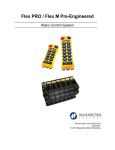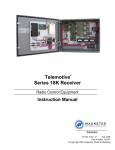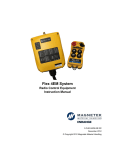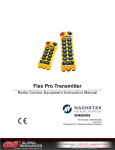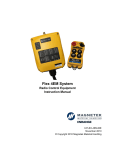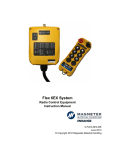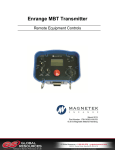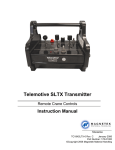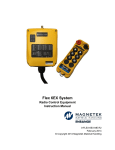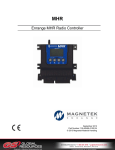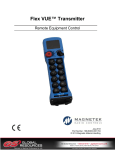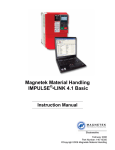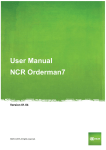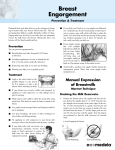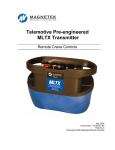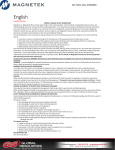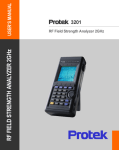Download Flex Pro Manual
Transcript
Flex Pro Transmitter Radio Control Equipment Instruction Manual 198-50003-R3 July 2011 © Copyright 2011 Magnetek Material Handling Service Information Your New Radio System Thank you for your purchase of Magnetek’s Enrange™ Flex Pro radio remote control system. Without a doubt, our Flex Pro system is the ultimate solution for providing precise, undeterred, and safe control of your material. If your product ever needs modification or service, please contact one of our representatives at the following locations: U.S. Service Information: For questions regarding service or technical information, contact: Magnetek, Inc. #5 Four Coins Drive Canonsburg, PA 15317 Telephone: 1.866.MAG.SERV (1.866.624.7378) Website: E-mail: www.magnetekmh.com [email protected] Fax Numbers: Main: 1.800.298.3503 Sales: 1.262.783.3510 Service: 1.262.783.3508 Canada Service Information: 4090B Sladeview Crescent Mississauga, Ontario L5L 5Y5 Canada Telephone: 1.800.792.7253 Fax: 1.905.828.5707 1.416.424.7617 (24/7 Service pager) Table of Contents Page 1. Introduction 3 2. Radio Controlled Safety 4 3. General Transmitter Information A. B. C. D. External Illustration (Pro 12 Configuration) Internal Illustration (Pro 12 Configuration) Types of Buttons Adjustable Speed Control 10 11 12 12 4. Dip-Switch Settings A. B. System Channel Settings Inactivity Time-Out 13 15 5. Operating Procedure A. B. C. D. E. General Operating Procedure Changing Transmitter Batteries Status Light Indicators & Warnings Push Button Error Table Trouble Shooting Tips 16 17 18 18 19 Flex Pro Instruction Manual July 2011 1 of 19 PRODUCT MANUAL SAFETY INFORMATION Magnetek, Inc. (Magnetek) offers a broad range of radio remote control products, control products and adjustable frequency drives, and industrial braking systems for material handling applications. This manual has been prepared by Magnetek to provide information and recommendations for the installation, use, operation and service of Magnetek’s material handling products and systems (Magnetek Products). Anyone who uses, operates, maintains, services, installs or owns Magnetek Products should know, understand and follow the instructions and safety recommendations in this manual for Magnetek Products. The recommendations in this manual do not take precedence over any of the following requirements relating to cranes, hoists lifting devices or other material handling equipment which use or include Magnetek Products: Instructions, manuals, and safety warnings of the manufacturers of the equipment where the radio system is used, Plant safety rules and procedures of the employers and the owners of facilities where the Magnetek Products are being used, Regulations issued by the Occupational Health and Safety Administration (OSHA), Applicable local, state or federal codes, ordinances, standards and requirements, or Safety standards and practices for the industries in which Magnetek Products are used. This manual does not include or address the specific instructions and safety warnings of these manufacturers or any of the other requirements listed above. It is the responsibility of the owners, users and operators of the Magnetek Products to know, understand and follow all of these requirements. It is the responsibility of the employer to make its employees aware of all of the above listed requirements and to make certain that all operators are properly trained. No one should use Magnetek Products prior to becoming familiar with and being trained in these requirements and the instructions and safety recommendations in this manual. WARRANTY INFORMATION FOR INFORMATION ON MAGNETEK’S PRODUCT WARRANTIES BY PRODUCT TYPE, PLEASE VISIT WWW.MAGNETEKMH.COM. Flex Pro Instruction Manual July 2011 2 of 19 1. Introduction The Flex radio remote control systems are designed for control of industrial equipment and mobile machinery such as overhead traveling cranes, construction equipment, forestry equipment, mining equipment, rail equipment, drilling & trenching equipment, agriculture equipment, electric hoists, winches, monorails, conveyor belts, mining equipment and other material handling equipment where wireless control is preferred. Each Flex system consists of a transmitter handset and standard-equipped accessories such as a transmitter waist belt, spare transmitter power key, clear vinyl pouch, “AA” alkaline batteries, compass direction decal sheet and user’s manual. List of notable features include: * 32 user-programmable channels – Advanced synthesized RF controls with 32 built-in channels; there are no more fixed channel and fragile quartz crystals to break. * Over one million unique ID codes (20bit) – Each and every Flex system has its own unique ID code; no repeats. * Advanced controls – The Flex system utilizes advanced microprocessor controls with 16-bit CRC which provides ultra fast, safe, precise, and error-free encoding and decoding. * Unique I-CHIP design – The I-CHIP functions in a way that is very similar to SIM cards used on mobile phones, with the ability to transfer system information and settings from one transmitter to another without the hassle of resetting the spares. * Reliable push buttons – The in-house designed push buttons are rated for more than one million press cycles. * Low power consumption – Requires only two “AA” Alkaline batteries for more than 100 hours of operating time between replacements. * Ultra-durable nylon and fiberglass composite enclosures – Highly resistant to breakage and deformation even in the most abusive environments. * Full compliance – All systems are fully compliant with the FCC Part-15 Rules, European Directives (Safety, EMC, R&TTE, and Machinery), and Industry Canada Specifications (IC). Flex Pro Instruction Manual July 2011 3 of 19 2. Radio Controlled Safety WARNINGS and CAUTIONS Throughout this document WARNING and CAUTION statements have been deliberately placed to highlight items critical to the protection of personnel and equipment. WARNING – A warning highlights an essential operating or maintenance procedure, practice, etc. which if not strictly observed, could result in injury or death of personnel, or long term physical hazards. Warnings are highlighted as shown below: WARNING CAUTION – A caution highlights an essential operating or maintenance procedure, practice, etc. which if not strictly observed, could result in damage to, or destruction of equipment, or loss of functional effectiveness. Cautions are highlighted as shown below: CAUTION WARNINGS and CAUTIONS SHOULD NEVER BE DISREGARDED. The safety rules in this section are not intended to replace any rules or regulations of any applicable local, state, or federal governing organizations. Always follow your local lockout and tagout procedure when maintaining any radio equipment. The following information is intended to be used in conjunction with other rules or regulations already in existence. It is important to read all of the safety information contained in this section before installing or operating the Radio Control System. Flex Pro Instruction Manual July 2011 4 of 19 2.1: CRITICAL INSTALLATION CONSIDERATIONS WARNING PRIOR TO INSTALLATION AND OPERATION OF THIS EQUIPMENT, READ AND DEVELOP AN UNDERSTANDING OF THE CONTENTS OF THIS MANUAL AND THE OPERATION MANUAL OF THE EQUIPMENT OR DEVICE TO WHICH THIS EQUIPMENT WILL BE INTERFACED. FAILURE TO FOLLOW THIS WARNING COULD RESULT IN SERIOUS INJURY OR DEATH AND DAMAGE TO EQUIPMENT. ALL EQUIPMENT MUST HAVE A MAINLINE CONTACTOR INSTALLED AND ALL TRACKED CRANES, HOISTS, LIFTING DEVICES AND SIMILAR EQUIPMENT MUST HAVE A BRAKE INSTALLED. FAILURE TO FOLLOW THIS WARNING COULD RESULT IN SERIOUS INJURY OR DEATH AND DAMAGE TO EQUIPMENT. AN AUDIBLE AND/OR VISUAL WARNING MEANS MUST BE PROVIDED ON ALL REMOTE CONTROLLED EQUIPMENT AS REQUIRED BY CODE, REGULATION, OR INDUSTRY STANDARD. THESE AUDIBLE AND/OR VISUAL WARNING DEVICES MUST MEET ALL GOVERNMENTAL REQUIREMENTS. FAILURE TO FOLLOW THIS WARNING COULD RESULT IN SERIOUS INJURY OR DEATH AND DAMAGE TO EQUIPMENT. FOLLOW YOUR LOCAL LOCKOUT TAGOUT PROCEDURE BEFORE MAINTAINING ANY REMOTE CONTROLLED EQUIPMENT. ALWAYS REMOVE ALL ELECTRICAL POWER FROM THE CRANE, HOIST, LIFTING DEVICE OR SIMILAR EQUIPMENT BEFORE ATTEMPTING ANY INSTALLATION PROCEDURES. DE-ENERGIZE AND TAGOUT ALL SOURCES OF ELECTRICAL POWER BEFORE TOUCH-TESTING ANY EQUIPMENT. FAILURE TO FOLLOW THIS WARNING COULD RESULT IN SERIOUS INJURY OR DEATH AND DAMAGE TO EQUIPMENT. THE DIRECT OUTPUTS OF THIS PRODUCT ARE NOT DESIGNED TO INTERFACE DIRECTLY TO TWO STATE SAFETY CRITICAL MAINTAINED FUNCTIONS, I.E., MAGNETS, VACUUM LIFTS, PUMPS, EMERGENCY EQUIPMENT, ETC. A MECHANICALLY LOCKING INTERMEDIATE RELAY SYSTEM WITH SEPARATE POWER CONSIDERATIONS MUST BE PROVIDED. FAILURE TO FOLLOW THIS WARNING COULD RESULT IN SERIOUS INJURY OR DEATH OR DAMAGE TO EQUIPMENT. 2.2: GENERAL Radio controlled material handling equipment operates in several directions. Cranes, hoists, lifting devices and other material handling equipment can be large, and operate at high speeds. Quite frequently, the equipment is operated in areas where people are working in close proximity to the material handling equipment. The operator must exercise extreme caution at all times. Workers must constantly be alert to avoid accidents. The following recommendations have been included to indicate how careful and thoughtful actions may prevent injuries, damage to equipment, or even save a life. 2.3: PERSONS AUTHORIZED TO OPERATE RADIO CONTROLLED CRANES Only properly trained persons designated by management should be permitted to operate radio controlled equipment. Radio controlled cranes, hoists, lifting devices and other material handling equipment should not be operated by any person who cannot read or understand signs, notices and operating instructions that pertain to the equipment. Radio controlled equipment should not be operated by any person with insufficient eyesight or hearing or by any person who may be suffering from a disorder or illness, is taking any medication that may cause loss of equipment control, or is under the influence of alcohol or drugs. Flex Pro Instruction Manual July 2011 5 of 19 2.4: SAFETY INFORMATION AND RECOMMENDED TRAINING FOR RADIO CONTROLLED EQUIPMENT OPERATORS Anyone being trained to operate radio controlled equipment should possess as a minimum the following knowledge and skills before using the radio controlled equipment. The operator should: have knowledge of hazards pertaining to equipment operation have knowledge of safety rules for radio controlled equipment have the ability to judge distance of moving objects know how to properly test prior to operation be trained in the safe operation of the radio transmitter as it pertains to the crane, hoist, lifting device or other material handling equipment being operated have knowledge of the use of equipment warning lights and alarms have knowledge of the proper storage space for a radio control transmitter when not in use be trained in transferring a radio control transmitter to another person be trained how and when to report unsafe or unusual operating conditions test the transmitter emergency stop and all warning devices prior to operation; testing should be done on each shift, without a load be thoroughly trained and knowledgeable in proper and safe operation of the crane, hoist, lifting device, or other material handling equipment that utilizes the radio control know how to keep the operator and other people clear of lifted loads and to avoid “pinch” points continuously watch and monitor status of lifted loads know and follow cable and hook inspection procedures know and follow the local lockout and tagout procedures when servicing radio controlled equipment know and follow all applicable operating and maintenance manuals, safety procedures, regulatory requirements, and industry standards and codes The operator shall not: lift or move more than the rated load operate the material handling equipment if the direction of travel or function engaged does not agree with what is indicated on the controller use the crane, hoist or lifting device to lift, support or transport people lift or carry any loads over people operate the crane, hoist or lifting device unless all persons, including the operator, are and remain clear of the supported load and any potential pinch points operate a crane, hoist or lifting device when the device is not centered over the load operate a crane, hoist or lifting device if the chain or wire rope is not seated properly in the sprockets, drum or sheave operate any damaged or malfunctioning crane, hoist, lifting device or other material handling equipment Flex Pro Instruction Manual July 2011 6 of 19 change any settings or controls without authorization and proper training remove or obscure any warning or safety labels or tags leave any load unattended while lifted leave power on the radio controlled equipment when the equipment is not in operation operate any material handling equipment using a damaged controller because the unit may be unsafe operate manual motions with other than manual power operate radio controlled equipment when low battery indicator is on WARNING THE OPERATOR SHOULD NOT ATTEMPT TO REPAIR ANY RADIO CONTROLLER. IF ANY PRODUCT PERFORMANCE OR SAFETY CONCERNS ARE OBSERVED, THE EQUIPMENT SHOULD IMMEDIATELY BE TAKEN OUT OF SERVICE AND BE REPORTED TO THE SUPERVISOR. DAMAGED AND INOPERABLE RADIO CONTROLLER EQUIPMENT SHOULD BE RETURNED TO MAGNETEK FOR EVALUATION AND REPAIR. FAILURE TO FOLLOW THIS WARNING COULD RESULT IN SERIOUS INJURY OR DEATH AND DAMAGE TO EQUIPMENT. 2.5: TRANSMITTER UNIT Transmitter switches should never be mechanically blocked ON or OFF. When not in use, the operator should turn the transmitter OFF. A secure storage space should be provided for the transmitter unit, and the transmitter unit should always be placed there when not in use. This precaution will help prevent unauthorized people from operating the material handling equipment. Spare transmitters should be stored in a secure storage space and only removed from the storage space after the current transmitter in use has been turned OFF, taken out of the service area and secured. 2.6: PRE-OPERATION TEST At the start of each work shift, or when a new operator takes control of the crane, operators should do, as a minimum, the following steps before making lifts with any crane or hoist: Test all warning devices. Test all direction and speed controls. Test the transmitter emergency stop. Flex Pro Instruction Manual July 2011 7 of 19 2.7: BATTERIES WARNING KNOW AND FOLLOW PROPER BATTERY HANDLING, CHARGING AND DISPOSAL PROCEDURES. IMPROPER BATTERY PROCEDURES CAN CAUSE BATTERIES TO EXPLODE OR DO OTHER SERIOUS DAMAGE. FAILURE TO FOLLOW THIS WARNING COULD RESULT IN SERIOUS INJURY OR DEATH AND DAMAGE TO EQUIPMENT. 2.8: BATTERY HANDLING Use only batteries approved by Magnetek for the specific product. Do not dispose of a battery pack in fire; it may explode. Do not attempt to open the battery pack. Do not short circuit the battery. For intrinsically safe environments only use specified Magnetek Telemotive intrinsically safe batteries. Keep the battery pack environment cool during charging operation and storage (i.e., not in direct sunlight or close to a heating source). 2.9: BATTERY CHARGING For those transmitters equipped with battery chargers, please familiarize all users with the instructions of the charger before attempting to use. Do not attempt to charge non-rechargeable battery packs. Avoid charging partially discharged rechargeable batteries to help prolong battery cycle life. Avoid charging the battery pack for more than 24 hours at a time. Do not charge batteries in a hazardous environment. Do not short the charger. Do not attempt to charge a damaged battery. Use only Magnetek Telemotive approved chargers for the appropriate battery pack. Do not attempt to use a battery that is leaking, swollen or corroded. Charger units are not intended for outdoor use. Use only indoors. 2.10: BATTERY DISPOSAL Before disposing of batteries consult local and governmental regulatory requirements for proper disposal procedure. Flex Pro Instruction Manual July 2011 8 of 19 2.11: SPECIFIC SYSTEM WARNINGS Below are some specific operating safety tips that should be strictly followed when operating a Flex Pro system: 1. Check the Status LED on the transmitter for any signs of low battery power (refer to page 18). 2. Check the Status LED on the transmitter for any signs of irregularities (refer to page 18). 3. Make sure the system is not set to the same channel as any other Flex systems in use within a distance of 300 meters (900 feet). 4. Never operate equipment with two transmitter handsets at the same time unless they are programmed to do so. Flex Pro Instruction Manual July 2011 9 of 19 3. General Transmitter Information A. External Illustration (Pro 12 Configuration) (Fig. 01) E. Emergency Stop Button (Fig. 02) 6. Push Button #6 SC. Strap Ring S. Removable Power Key Switch 7. Push Button #7 SN. System Information 1. Push Button #1 8. Push Button #8 RN. System Channel 2. Push Button #2 9. Push Button #9 MN. Crane Number 3. Push Button #3 10. Push Button #10 FC. FCC Information 4. Push Button #4 11. Push Button #11 5. Push Button #5 12. Push Button #12 NOTE: Push Buttons #9-#12 are not present on the Flex Pro 8 Module Flex Pro Instruction Manual July 2011 10 of 19 B. Internal Illustration (Pro 12 Configuration) (Fig. 03) 1. 2. 3. 4. 5. Encoder Board Aerial Antenna Transmitting Module Status LED Display Function LED Displays (Fig. 04) 6. 7. 8. I-CHIP Dip-Switch Battery Contact Mechanism NOTE: Flex Pro 8 Module will differ slightly Flex Pro Instruction Manual July 2011 11 of 19 C. Types of Buttons The buttons used on the Flex Pro are fully proportional, stepless push buttons with an output that varies 0-100% (based on how far the button is depressed). It is possible to model the stepless buttons as an On/Off momentary switch, On/Off latched switch, 2 Speed button, or a 3 Speed button. This modeling is done on the receiver end of the system. Please consult the factory for more information. D. Adjustable Speed Control The proportional buttons normally operate on a scale from 0-100%, but can also be scaled down to operate linearly from 0-75%, 0-50%, or 0-25% over the full motion of the button. This gives the user more control over lower speeds. To adjust the speed control settings, press and hold the Start button, then press push button 1 or push button 2 to decrement/increment the range percentage. The red LEDs, which indicate the Speed Setting, will then change to reflect the current setting. Start + Speed control setting PB1 Decrement Speed Control PB2 Increment Speed Control (Fig. 05) (Fig. 06) Flex Pro Instruction Manual July 2011 12 of 19 4. Dip-Switch Settings A. System Channel Settings Set the transmitter channel by adjusting the channel dip-switch located on the backside of the transmitter encoder board (refer to Fig. 07 below). Only the first five (5) positions of the dip-switch are used for channel programming (refer to Fig. 08 below). The system channels table (on page 14) illustrates which dip-switch setting corresponds to which channel. Once the transmitter channel is altered, you must set up the receiver to recognize the transmitters on its new channel. (Fig. 07) (Fig. 08) Top slot → “1” Bottom slot → “0” The above dip-switch setting “1 0 0 1 0” corresponds to “channel 19” in the system channels table (on page 14). Flex Pro Instruction Manual July 2011 13 of 19 System Channel Table Dip-switch Channel Setting Frequency Dip-switch Setting 17 433.800MHZ 10000 00001 18 433.850MHZ 10001 433.100MHZ 00010 19 433.900MHZ 10010 04 433.150MHZ 00011 20 433.950MHZ 10011 05 433.200MHZ 00100 21 434.000MHZ 10100 06 433.250MHZ 00101 22 434.050MHZ 10101 07 433.300MHZ 00110 23 434.100MHZ 10110 08 433.350MHZ 00111 24 434.150MHZ 10111 09 433.400MHZ 01000 25 434.200MHZ 11000 10 433.450MHZ 01001 26 434.250MHZ 11001 11 433.500MHZ 01010 27 434.300MHZ 11010 12 433.550MHZ 01011 28 434.350MHZ 11011 13 433.600MHZ 01100 29 434.400MHZ 11100 14 433.650MHZ 01101 30 434.450MHZ 11101 15 433.700MHZ 01110 31 434.500MHZ 11110 16 433.750MHZ 01111 32 434.550MHZ 11111 Channel Frequency 01 433.000MHZ 00000 02 433.050MHZ 03 Flex Pro Instruction Manual July 2011 14 of 19 B. Inactivity Time-Out Timer Bits 6 and 7 on the dip-switch allows the user to define a time after which, if no buttons on the transmitter are pressed, the Flex Pro will send an OFF command to the receiver and power down. To restart, the user must turn the On/Off/Start switch to the Off position, then back to On again to resume operation. Time Out Dipswitch Setting 5 minutes 01 10 minutes 10 15 minutes 11 Never shut off 00 (Fig.09) Flex Pro Instruction Manual July 2011 15 of 19 5. Operating Procedure A. General Operating Procedure 1. Reset the red emergency stop button located on the top left hand side of the transmitter handset by rotating it either clockwise or counter clockwise. The red button will pop up. (Fig. 10) 2. Turn on the transmitter power by inserting the black-colored key into the power key slot located on the top right hand side of the transmitter handset and rotate it clockwise to the “On” position. (Fig. 11) (Fig. 12) 3. After turning on the transmitter power, check the Status LED on the transmitter handset for any sign of system irregularities (refer to “Status Light Indicators & Warnings” on page 18). If the system is normal the Status LED will light up green for two (2) seconds, then slowly flash green. 4. If there are no signs of any system irregularities, then rotate the power key further clockwise to the “Start” position for up to 2 seconds. This will activate the receiver E-Stop. Thereafter, the same “Start” position will become an auxiliary function with momentary contact. (Fig. 13) Flex Pro Instruction Manual July 2011 16 of 19 B. 5. Now press any push button on the transmitter handset to operate the equipment. When a button is pressed, the Status LED will flash orange with a variable speed dependent on how far the button is pressed. The further a button is pressed, the faster the LED will flash. When no buttons are pressed, the Status LED will slowly blink green. 6. In case of an emergency, pressing down on the red emergency stop button will immediately disconnect the receiver E-Stop and turn off the unit. To reset the emergency stop button just rotate the red button either clockwise or counterclockwise and then cycle power to the unit. 7. After a period of inactivity (push button not pressed) defined by the dip-switch, the receiver ESTOP will be disconnected and the unit must cycle power before turning on again. 8. Turn off the transmitter power by rotating the power key counter-clockwise to the “Off” position (Status LED becomes a solid red for 4 seconds). This will disconnect the transmitter power and the receiver E-Stop altogether. Turn it further counter-clockwise to release the key. Changing Transmitter Batteries Change the transmitter batteries by unscrewing the battery cover located on the backside of the transmitter (refer to Fig. 14 and Fig. 15 below). During battery installation make sure that the ribbon is centered between the two batteries. After changing the batteries also make sure that all screws are tightened to avoid water, moisture, dirt, grease, or other liquid penetration. 2 1 ↓ (Fig. 14) (Fig. 15) Flex Pro Instruction Manual July 2011 17 of 19 C. Status Light Indicators & Warnings Type Display Type Indication 1 Slow green blink (Normal Operation) Transmitter on and in standby. 2 Blinking orange Button has been pressed and the unit is transmitting. The speed at which the orange LED blinks is directly related to how far down the button is pressed. 3 1 red blink followed by a 2second pause Voltage goes below 1.9V during operation change batteries immediately. 4 2 red blinks followed by a 2-second pause A push button is active while turning on the transmitter. The button that is active will be designated by the (25, 50, 75, 100) LEDs. See Push Button Error Table below. 5 3 red blinks followed by a 2-second pause I-CHIP error. 6 4 red blinks followed by a 2-second pause Transmitting error, system can not lock on to the designated channel. 7 Constant green for up to 2 seconds Transmitter power on with no faults detected (prior to initiating the START function). 8 Solid Red Stop command initiated with receiver ESTOP deactivated. 9 Solid Red Voltage goes below 1.9V at initial power on - transmitter power shuts off. D. Push Button Error Table 25 OFF OFF OFF OFF OFF OFF OFF ON ON ON ON ON 50 OFF OFF OFF ON ON ON ON OFF OFF OFF OFF ON 75 OFF ON ON OFF OFF ON ON OFF OFF ON ON OFF 100 ON OFF ON OFF ON OFF ON OFF ON OFF ON OFF Push Button 1 2 3 4 5 6 7 8 9 10 11 12 Flex Pro Instruction Manual July 2011 18 of 19 E. Trouble Shooting Tips Problems Possible Reasons Suggestions Transmitter low battery power Check the transmitter battery level. Emergency stop button activated prior to startup No response when transmitter push button is pressed (Improper startup & settings) Improper startup procedure Prior to turning on the transmitter power switch make sure that the red emergency stop button is elevated. Redo the startup procedure by holding the power key at “START” position for up to 2.0 seconds and then release. Incorrect system RF channel Make sure that the transmitter handset and the receiver unit both have the same channel. Incorrect Receiver Access Code Make sure that the transmitter handset and receiver unit both have the same Receiver Access Code. System out of range Make sure that the startup procedure is initiated within 100 meters (300 feet) from the receiver location. Flex Pro Instruction Manual July 2011 19 of 19





















